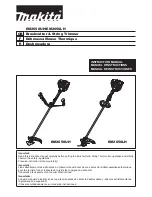
Performing inspection / maintenance
Permeation of Protective Gloves According to EN 374-3:1994
This standard pertains to determining the resistance provided by the material
of protective gloves against the permeation of nongaseous, potentially
hazardous chemicals when subjected to continuous contact.
For each chemical the combinations of protective glove and test chemical are
classified according to their penetration/breakthrough time in which the glove
prevents permeation.
The protection index indicated is based on the penetration/breakthrough time
determined during constant contact with the test chemical under customary
laboratory conditions as specified in EN374-3. The actual duration of
protection at the workplace may deviate considerably from this protection
index.
Pursuant to European standard EN 374-3:1994, permeation is classified
according to a protection index, which is subdivided into six levels.
EN
374-3:1994 — Specification of the Results:
Assuming permeation takes place, the breakthrough time is given in minutes
for each test sample. The average breakthrough time for each type of
material is also indicated. The duration of testing is given if no breakthrough
occurs.
Protection Index
Class 1
Class 2
Class 3
Class 4
Class 5
Class 6
> 10 min.
> 30 min.
> 60 min.
> 120 min.
> 240 min.
> 480 min.
For example:
For example:
For example:
For example:
For example:
For example:
-
Acetone
Benzene
Chloroform
-
Toluene
-
Benzaldehyde
Nitrobenzene
-
Naphtha benzene
Aniline
-
n-Heptane
Ethyl alcohol
-
Isooctane
Ethylenediamine
-
Formic acid, 10% by
vol.
Ammonia, 10% by vol.
Glycerin
Potassium nitrate
Sulfuric acid, 50% by
vol.
This means that when the user is constantly exposed to the chemical it takes
a minimum of
²
min
1
cm
g
×
m
to permeate the glove and come into contact with the
user's skin.
Standard EN374 subdivides gloves into six classes, class 6 being the highest
and most resistant. During testing, the glove is completely immersed in the
medium. No documentation of resistance in excess of 480 min. takes place.
This means that gloves which may provide for resistance to breakthrough for
1 month or longer are also categorized as class 6.
Chemical
Example
Neoprene
(CR)
Hydrocarbon mixture, aliphatic
C 11-
13
G 60 Special
Class 6
The data in this test list was collected under laboratory conditions using new
gloves without any mechanical action at room temperature. The gloves were
continuously subjected to full contact. This information can only be used for
CTU 1x3x Series
en(us)
Page 72 / 92
BeWa CTU1x3x 3631694d en-us 2017-03-13.docx
2017-03-13
















































